Comprehensive Business Strategy Report: TESCO's Competitive Analysis
VerifiedAdded on 2021/02/22
|17
|4908
|55
Report
AI Summary
This report provides a comprehensive analysis of TESCO's business strategy, starting with an introduction to business strategy and its importance. It then delves into a detailed macro-environmental analysis using the PESTLE framework, examining political, economic, social, technological, legal, and environmental factors impacting TESCO. The report also conducts a stakeholder analysis to understand the influence of various groups. An internal analysis follows, employing SWOT and Value Chain analyses to assess TESCO's strengths, weaknesses, opportunities, and threats, as well as its primary and support activities. Furthermore, the report incorporates Porter's Five Forces model to evaluate the competitive landscape. Finally, the report concludes with strategic planning and recommendations for TESCO, highlighting strategic choices and a strategic management plan to enhance its market position and competitive advantage within the UK retail market and beyond. The report uses various models and frameworks to provide a clear and detailed understanding of TESCO's strategic approach.
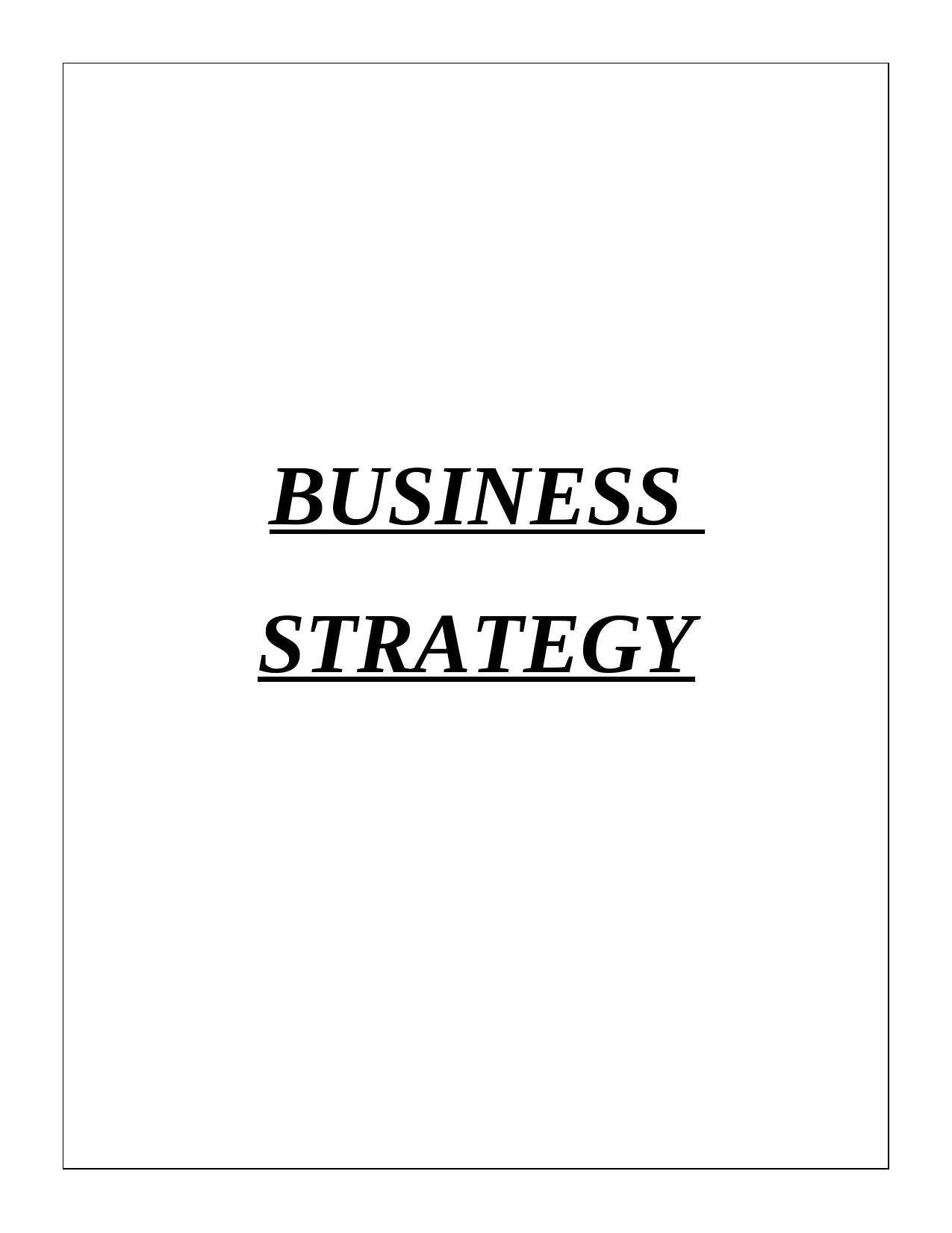
BUSINESS
STRATEGY
STRATEGY
Paraphrase This Document
Need a fresh take? Get an instant paraphrase of this document with our AI Paraphraser
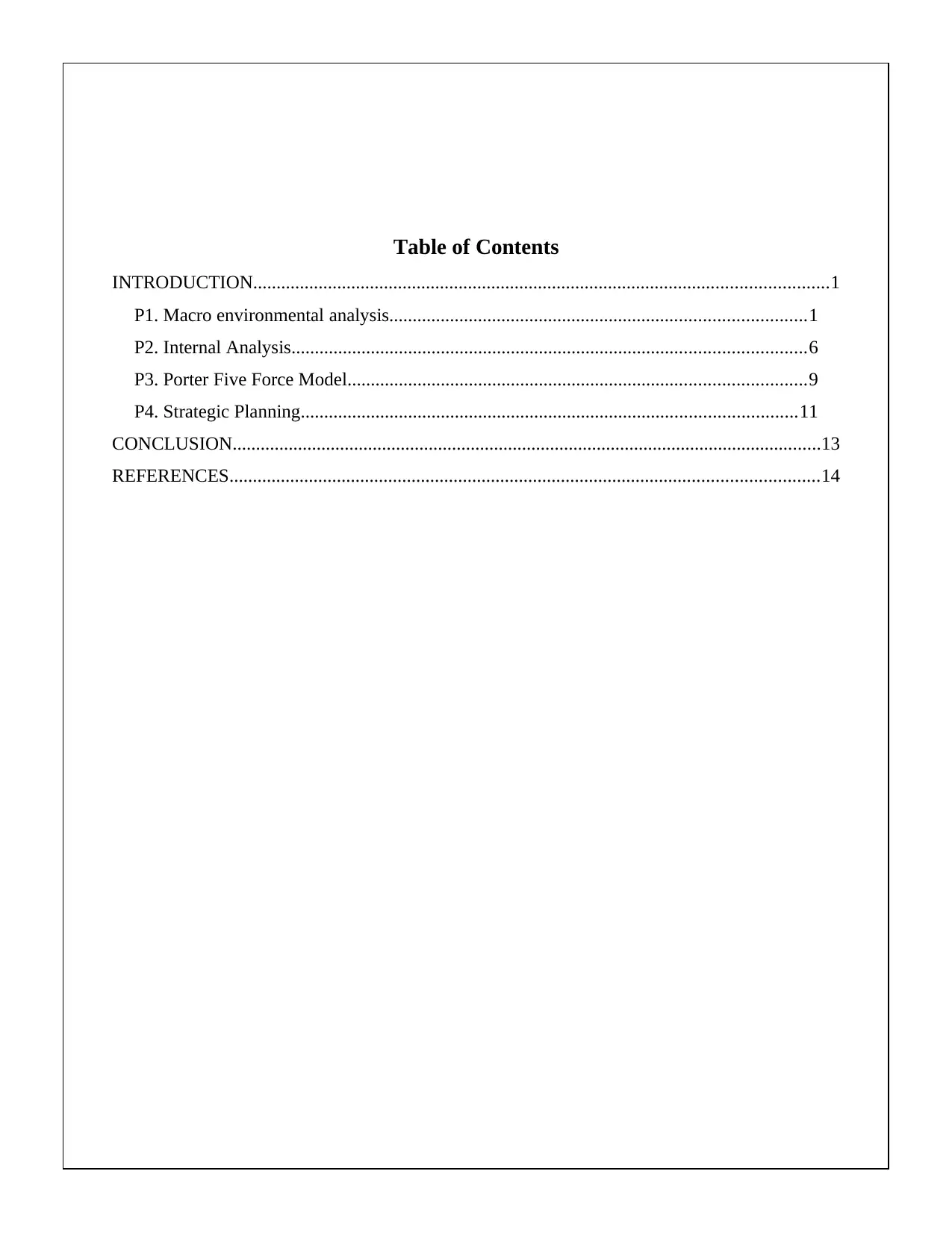
Table of Contents
INTRODUCTION...........................................................................................................................1
P1. Macro environmental analysis.........................................................................................1
P2. Internal Analysis..............................................................................................................6
P3. Porter Five Force Model..................................................................................................9
P4. Strategic Planning..........................................................................................................11
CONCLUSION..............................................................................................................................13
REFERENCES..............................................................................................................................14
INTRODUCTION...........................................................................................................................1
P1. Macro environmental analysis.........................................................................................1
P2. Internal Analysis..............................................................................................................6
P3. Porter Five Force Model..................................................................................................9
P4. Strategic Planning..........................................................................................................11
CONCLUSION..............................................................................................................................13
REFERENCES..............................................................................................................................14
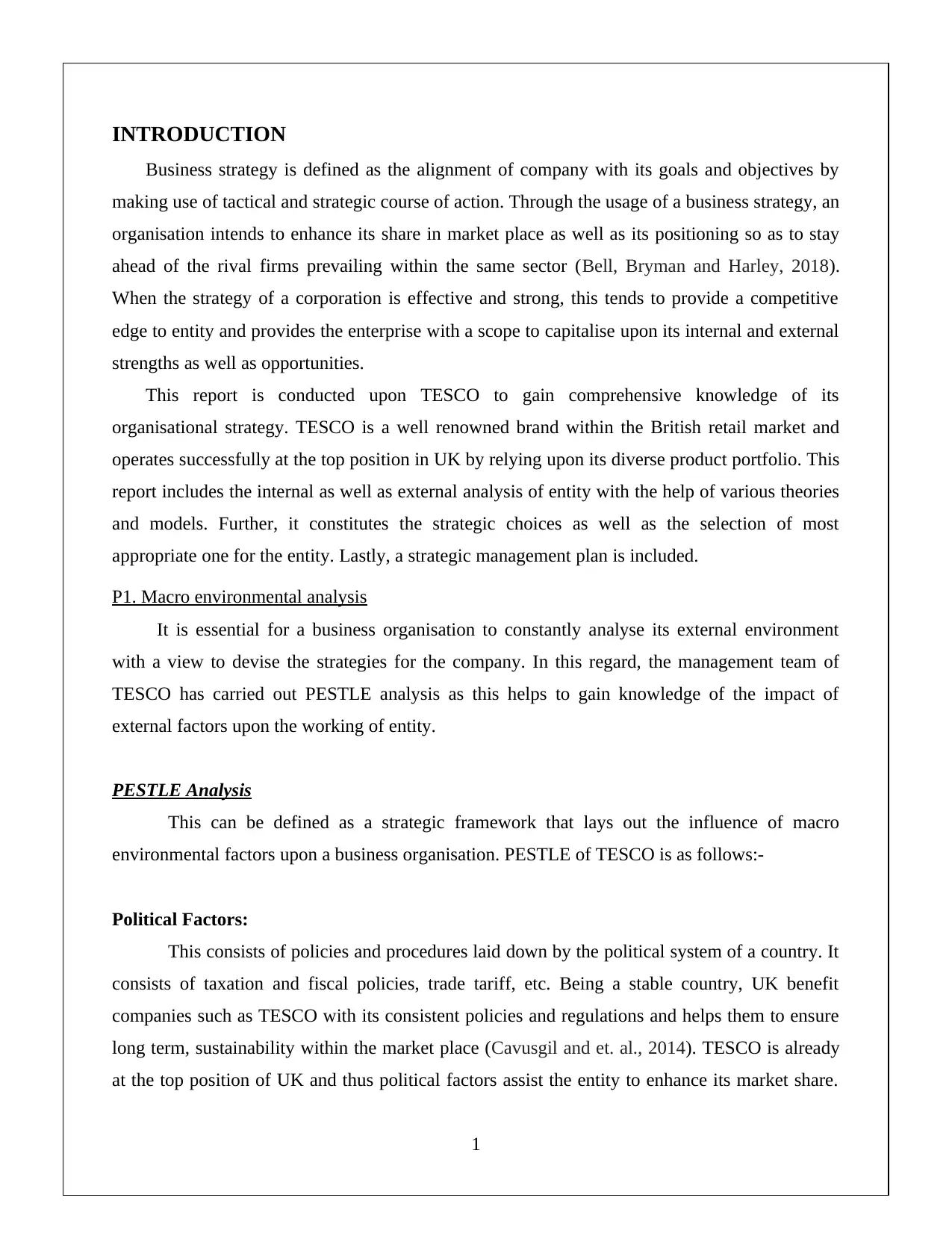
INTRODUCTION
Business strategy is defined as the alignment of company with its goals and objectives by
making use of tactical and strategic course of action. Through the usage of a business strategy, an
organisation intends to enhance its share in market place as well as its positioning so as to stay
ahead of the rival firms prevailing within the same sector (Bell, Bryman and Harley, 2018).
When the strategy of a corporation is effective and strong, this tends to provide a competitive
edge to entity and provides the enterprise with a scope to capitalise upon its internal and external
strengths as well as opportunities.
This report is conducted upon TESCO to gain comprehensive knowledge of its
organisational strategy. TESCO is a well renowned brand within the British retail market and
operates successfully at the top position in UK by relying upon its diverse product portfolio. This
report includes the internal as well as external analysis of entity with the help of various theories
and models. Further, it constitutes the strategic choices as well as the selection of most
appropriate one for the entity. Lastly, a strategic management plan is included.
P1. Macro environmental analysis
It is essential for a business organisation to constantly analyse its external environment
with a view to devise the strategies for the company. In this regard, the management team of
TESCO has carried out PESTLE analysis as this helps to gain knowledge of the impact of
external factors upon the working of entity.
PESTLE Analysis
This can be defined as a strategic framework that lays out the influence of macro
environmental factors upon a business organisation. PESTLE of TESCO is as follows:-
Political Factors:
This consists of policies and procedures laid down by the political system of a country. It
consists of taxation and fiscal policies, trade tariff, etc. Being a stable country, UK benefit
companies such as TESCO with its consistent policies and regulations and helps them to ensure
long term, sustainability within the market place (Cavusgil and et. al., 2014). TESCO is already
at the top position of UK and thus political factors assist the entity to enhance its market share.
1
Business strategy is defined as the alignment of company with its goals and objectives by
making use of tactical and strategic course of action. Through the usage of a business strategy, an
organisation intends to enhance its share in market place as well as its positioning so as to stay
ahead of the rival firms prevailing within the same sector (Bell, Bryman and Harley, 2018).
When the strategy of a corporation is effective and strong, this tends to provide a competitive
edge to entity and provides the enterprise with a scope to capitalise upon its internal and external
strengths as well as opportunities.
This report is conducted upon TESCO to gain comprehensive knowledge of its
organisational strategy. TESCO is a well renowned brand within the British retail market and
operates successfully at the top position in UK by relying upon its diverse product portfolio. This
report includes the internal as well as external analysis of entity with the help of various theories
and models. Further, it constitutes the strategic choices as well as the selection of most
appropriate one for the entity. Lastly, a strategic management plan is included.
P1. Macro environmental analysis
It is essential for a business organisation to constantly analyse its external environment
with a view to devise the strategies for the company. In this regard, the management team of
TESCO has carried out PESTLE analysis as this helps to gain knowledge of the impact of
external factors upon the working of entity.
PESTLE Analysis
This can be defined as a strategic framework that lays out the influence of macro
environmental factors upon a business organisation. PESTLE of TESCO is as follows:-
Political Factors:
This consists of policies and procedures laid down by the political system of a country. It
consists of taxation and fiscal policies, trade tariff, etc. Being a stable country, UK benefit
companies such as TESCO with its consistent policies and regulations and helps them to ensure
long term, sustainability within the market place (Cavusgil and et. al., 2014). TESCO is already
at the top position of UK and thus political factors assist the entity to enhance its market share.
1
⊘ This is a preview!⊘
Do you want full access?
Subscribe today to unlock all pages.

Trusted by 1+ million students worldwide
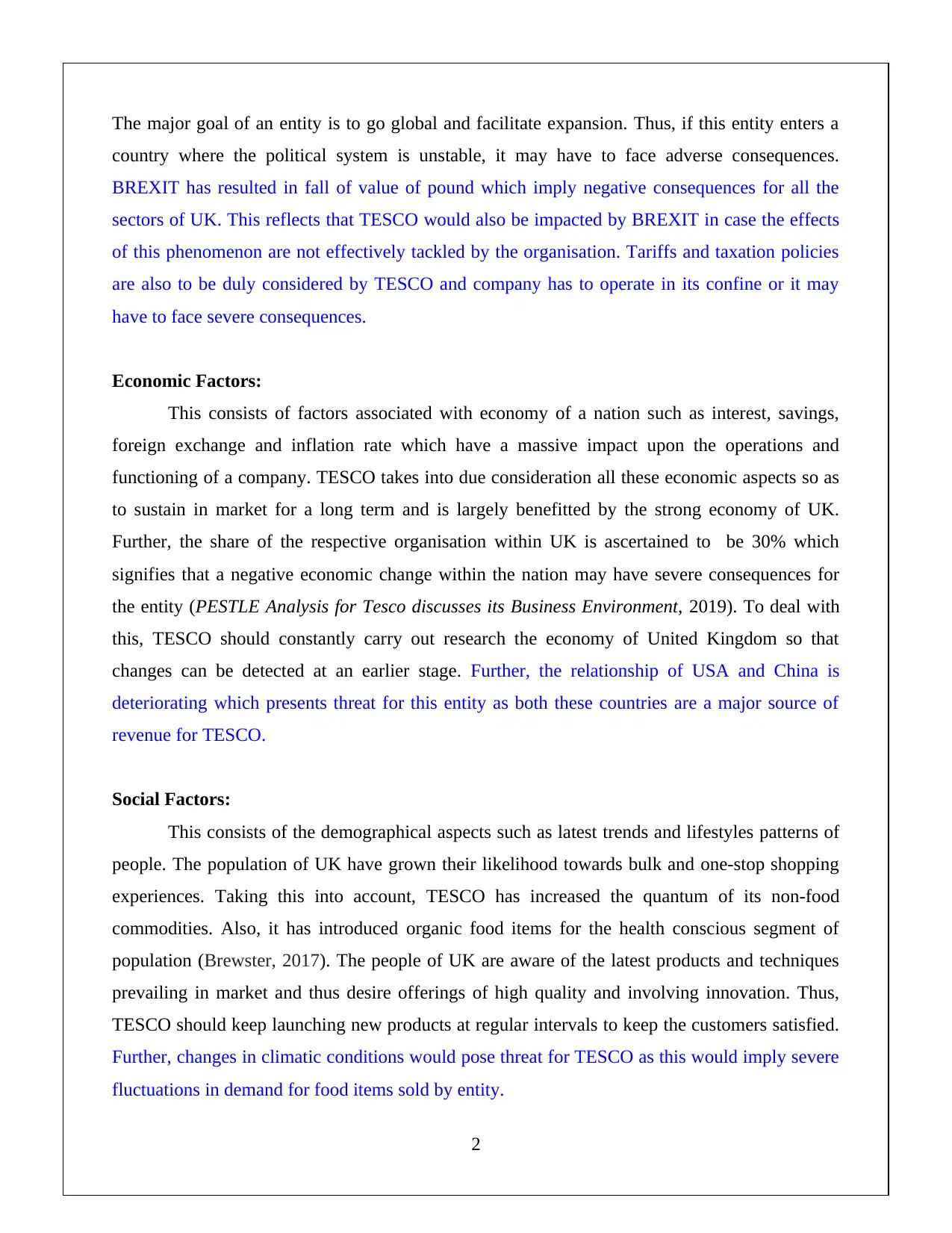
The major goal of an entity is to go global and facilitate expansion. Thus, if this entity enters a
country where the political system is unstable, it may have to face adverse consequences.
BREXIT has resulted in fall of value of pound which imply negative consequences for all the
sectors of UK. This reflects that TESCO would also be impacted by BREXIT in case the effects
of this phenomenon are not effectively tackled by the organisation. Tariffs and taxation policies
are also to be duly considered by TESCO and company has to operate in its confine or it may
have to face severe consequences.
Economic Factors:
This consists of factors associated with economy of a nation such as interest, savings,
foreign exchange and inflation rate which have a massive impact upon the operations and
functioning of a company. TESCO takes into due consideration all these economic aspects so as
to sustain in market for a long term and is largely benefitted by the strong economy of UK.
Further, the share of the respective organisation within UK is ascertained to be 30% which
signifies that a negative economic change within the nation may have severe consequences for
the entity (PESTLE Analysis for Tesco discusses its Business Environment, 2019). To deal with
this, TESCO should constantly carry out research the economy of United Kingdom so that
changes can be detected at an earlier stage. Further, the relationship of USA and China is
deteriorating which presents threat for this entity as both these countries are a major source of
revenue for TESCO.
Social Factors:
This consists of the demographical aspects such as latest trends and lifestyles patterns of
people. The population of UK have grown their likelihood towards bulk and one-stop shopping
experiences. Taking this into account, TESCO has increased the quantum of its non-food
commodities. Also, it has introduced organic food items for the health conscious segment of
population (Brewster, 2017). The people of UK are aware of the latest products and techniques
prevailing in market and thus desire offerings of high quality and involving innovation. Thus,
TESCO should keep launching new products at regular intervals to keep the customers satisfied.
Further, changes in climatic conditions would pose threat for TESCO as this would imply severe
fluctuations in demand for food items sold by entity.
2
country where the political system is unstable, it may have to face adverse consequences.
BREXIT has resulted in fall of value of pound which imply negative consequences for all the
sectors of UK. This reflects that TESCO would also be impacted by BREXIT in case the effects
of this phenomenon are not effectively tackled by the organisation. Tariffs and taxation policies
are also to be duly considered by TESCO and company has to operate in its confine or it may
have to face severe consequences.
Economic Factors:
This consists of factors associated with economy of a nation such as interest, savings,
foreign exchange and inflation rate which have a massive impact upon the operations and
functioning of a company. TESCO takes into due consideration all these economic aspects so as
to sustain in market for a long term and is largely benefitted by the strong economy of UK.
Further, the share of the respective organisation within UK is ascertained to be 30% which
signifies that a negative economic change within the nation may have severe consequences for
the entity (PESTLE Analysis for Tesco discusses its Business Environment, 2019). To deal with
this, TESCO should constantly carry out research the economy of United Kingdom so that
changes can be detected at an earlier stage. Further, the relationship of USA and China is
deteriorating which presents threat for this entity as both these countries are a major source of
revenue for TESCO.
Social Factors:
This consists of the demographical aspects such as latest trends and lifestyles patterns of
people. The population of UK have grown their likelihood towards bulk and one-stop shopping
experiences. Taking this into account, TESCO has increased the quantum of its non-food
commodities. Also, it has introduced organic food items for the health conscious segment of
population (Brewster, 2017). The people of UK are aware of the latest products and techniques
prevailing in market and thus desire offerings of high quality and involving innovation. Thus,
TESCO should keep launching new products at regular intervals to keep the customers satisfied.
Further, changes in climatic conditions would pose threat for TESCO as this would imply severe
fluctuations in demand for food items sold by entity.
2
Paraphrase This Document
Need a fresh take? Get an instant paraphrase of this document with our AI Paraphraser
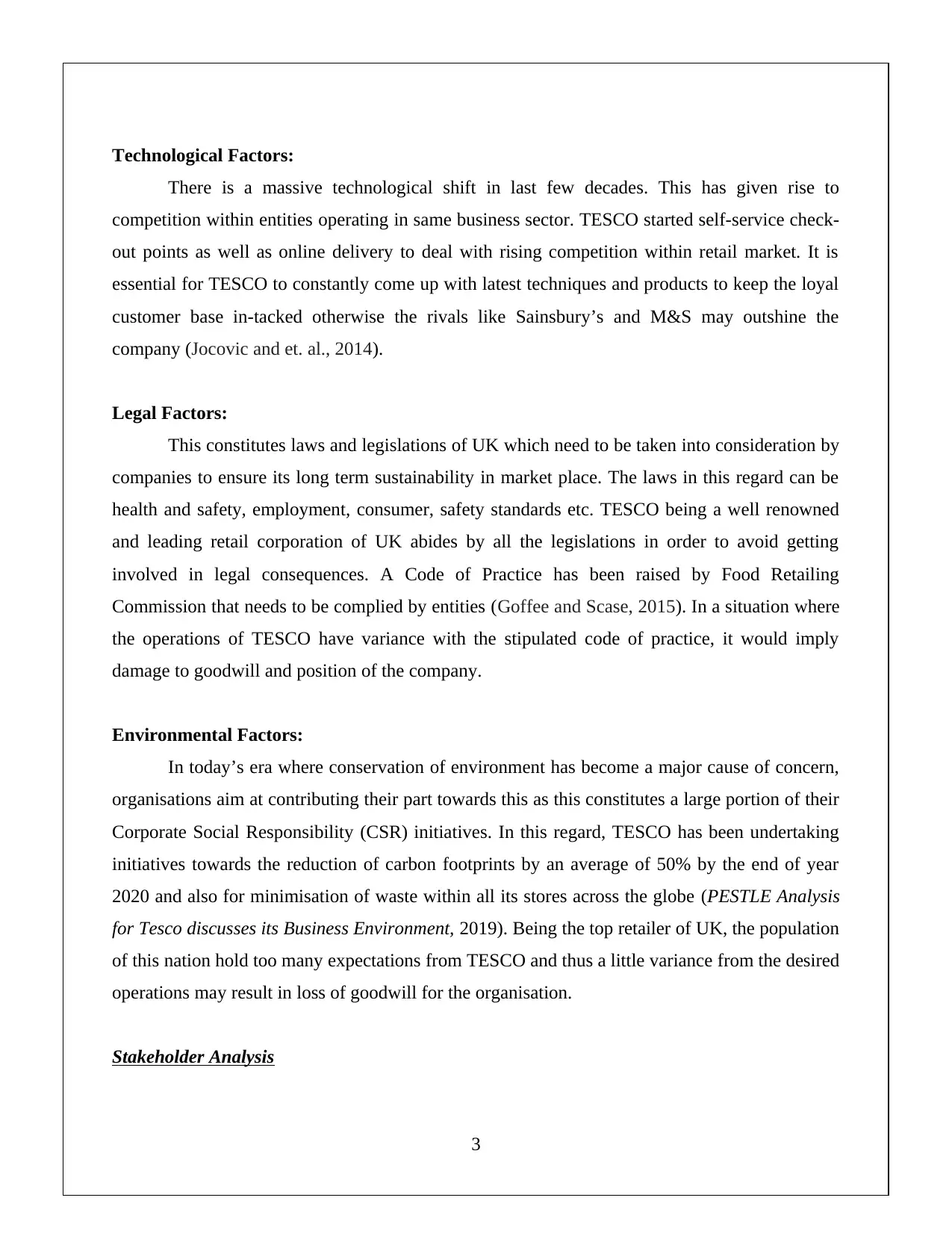
Technological Factors:
There is a massive technological shift in last few decades. This has given rise to
competition within entities operating in same business sector. TESCO started self-service check-
out points as well as online delivery to deal with rising competition within retail market. It is
essential for TESCO to constantly come up with latest techniques and products to keep the loyal
customer base in-tacked otherwise the rivals like Sainsbury’s and M&S may outshine the
company (Jocovic and et. al., 2014).
Legal Factors:
This constitutes laws and legislations of UK which need to be taken into consideration by
companies to ensure its long term sustainability in market place. The laws in this regard can be
health and safety, employment, consumer, safety standards etc. TESCO being a well renowned
and leading retail corporation of UK abides by all the legislations in order to avoid getting
involved in legal consequences. A Code of Practice has been raised by Food Retailing
Commission that needs to be complied by entities (Goffee and Scase, 2015). In a situation where
the operations of TESCO have variance with the stipulated code of practice, it would imply
damage to goodwill and position of the company.
Environmental Factors:
In today’s era where conservation of environment has become a major cause of concern,
organisations aim at contributing their part towards this as this constitutes a large portion of their
Corporate Social Responsibility (CSR) initiatives. In this regard, TESCO has been undertaking
initiatives towards the reduction of carbon footprints by an average of 50% by the end of year
2020 and also for minimisation of waste within all its stores across the globe (PESTLE Analysis
for Tesco discusses its Business Environment, 2019). Being the top retailer of UK, the population
of this nation hold too many expectations from TESCO and thus a little variance from the desired
operations may result in loss of goodwill for the organisation.
Stakeholder Analysis
3
There is a massive technological shift in last few decades. This has given rise to
competition within entities operating in same business sector. TESCO started self-service check-
out points as well as online delivery to deal with rising competition within retail market. It is
essential for TESCO to constantly come up with latest techniques and products to keep the loyal
customer base in-tacked otherwise the rivals like Sainsbury’s and M&S may outshine the
company (Jocovic and et. al., 2014).
Legal Factors:
This constitutes laws and legislations of UK which need to be taken into consideration by
companies to ensure its long term sustainability in market place. The laws in this regard can be
health and safety, employment, consumer, safety standards etc. TESCO being a well renowned
and leading retail corporation of UK abides by all the legislations in order to avoid getting
involved in legal consequences. A Code of Practice has been raised by Food Retailing
Commission that needs to be complied by entities (Goffee and Scase, 2015). In a situation where
the operations of TESCO have variance with the stipulated code of practice, it would imply
damage to goodwill and position of the company.
Environmental Factors:
In today’s era where conservation of environment has become a major cause of concern,
organisations aim at contributing their part towards this as this constitutes a large portion of their
Corporate Social Responsibility (CSR) initiatives. In this regard, TESCO has been undertaking
initiatives towards the reduction of carbon footprints by an average of 50% by the end of year
2020 and also for minimisation of waste within all its stores across the globe (PESTLE Analysis
for Tesco discusses its Business Environment, 2019). Being the top retailer of UK, the population
of this nation hold too many expectations from TESCO and thus a little variance from the desired
operations may result in loss of goodwill for the organisation.
Stakeholder Analysis
3
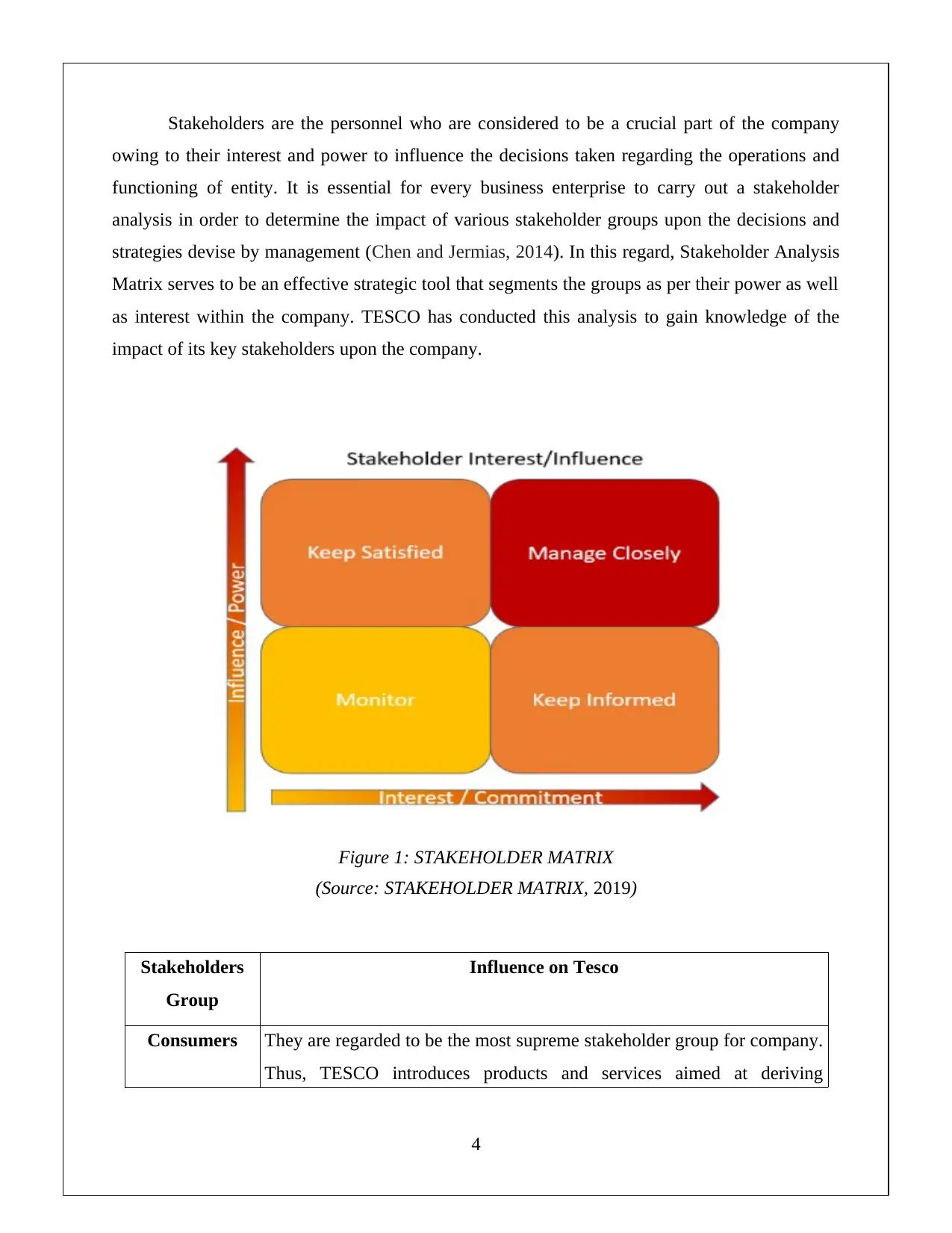
Stakeholders are the personnel who are considered to be a crucial part of the company
owing to their interest and power to influence the decisions taken regarding the operations and
functioning of entity. It is essential for every business enterprise to carry out a stakeholder
analysis in order to determine the impact of various stakeholder groups upon the decisions and
strategies devise by management (Chen and Jermias, 2014). In this regard, Stakeholder Analysis
Matrix serves to be an effective strategic tool that segments the groups as per their power as well
as interest within the company. TESCO has conducted this analysis to gain knowledge of the
impact of its key stakeholders upon the company.
Figure 1: STAKEHOLDER MATRIX
(Source: STAKEHOLDER MATRIX, 2019)
Stakeholders
Group
Influence on Tesco
Consumers They are regarded to be the most supreme stakeholder group for company.
Thus, TESCO introduces products and services aimed at deriving
4
owing to their interest and power to influence the decisions taken regarding the operations and
functioning of entity. It is essential for every business enterprise to carry out a stakeholder
analysis in order to determine the impact of various stakeholder groups upon the decisions and
strategies devise by management (Chen and Jermias, 2014). In this regard, Stakeholder Analysis
Matrix serves to be an effective strategic tool that segments the groups as per their power as well
as interest within the company. TESCO has conducted this analysis to gain knowledge of the
impact of its key stakeholders upon the company.
Figure 1: STAKEHOLDER MATRIX
(Source: STAKEHOLDER MATRIX, 2019)
Stakeholders
Group
Influence on Tesco
Consumers They are regarded to be the most supreme stakeholder group for company.
Thus, TESCO introduces products and services aimed at deriving
4
⊘ This is a preview!⊘
Do you want full access?
Subscribe today to unlock all pages.

Trusted by 1+ million students worldwide
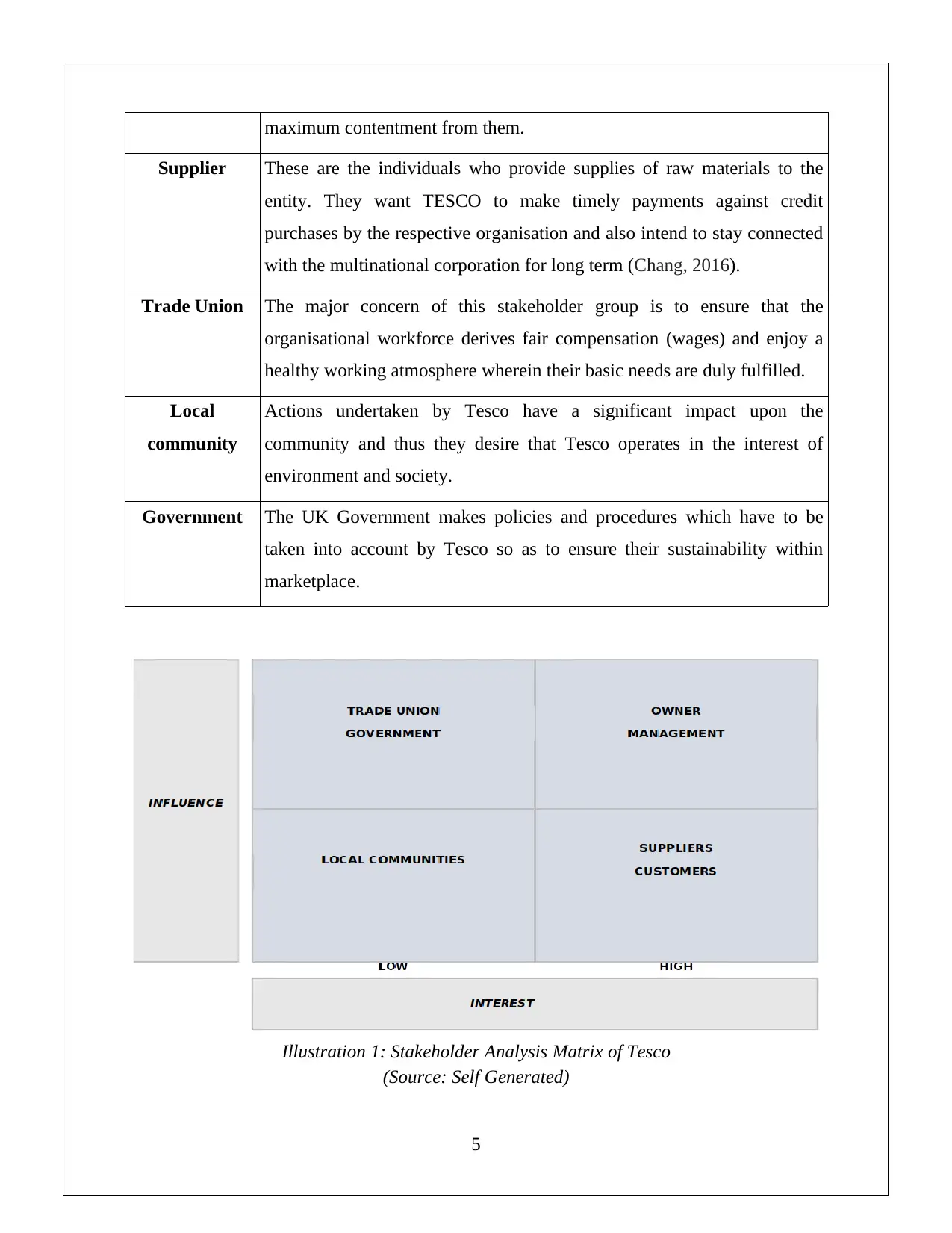
maximum contentment from them.
Supplier These are the individuals who provide supplies of raw materials to the
entity. They want TESCO to make timely payments against credit
purchases by the respective organisation and also intend to stay connected
with the multinational corporation for long term (Chang, 2016).
Trade Union The major concern of this stakeholder group is to ensure that the
organisational workforce derives fair compensation (wages) and enjoy a
healthy working atmosphere wherein their basic needs are duly fulfilled.
Local
community
Actions undertaken by Tesco have a significant impact upon the
community and thus they desire that Tesco operates in the interest of
environment and society.
Government The UK Government makes policies and procedures which have to be
taken into account by Tesco so as to ensure their sustainability within
marketplace.
(Source: Self Generated)
5
Illustration 1: Stakeholder Analysis Matrix of Tesco
Supplier These are the individuals who provide supplies of raw materials to the
entity. They want TESCO to make timely payments against credit
purchases by the respective organisation and also intend to stay connected
with the multinational corporation for long term (Chang, 2016).
Trade Union The major concern of this stakeholder group is to ensure that the
organisational workforce derives fair compensation (wages) and enjoy a
healthy working atmosphere wherein their basic needs are duly fulfilled.
Local
community
Actions undertaken by Tesco have a significant impact upon the
community and thus they desire that Tesco operates in the interest of
environment and society.
Government The UK Government makes policies and procedures which have to be
taken into account by Tesco so as to ensure their sustainability within
marketplace.
(Source: Self Generated)
5
Illustration 1: Stakeholder Analysis Matrix of Tesco
Paraphrase This Document
Need a fresh take? Get an instant paraphrase of this document with our AI Paraphraser
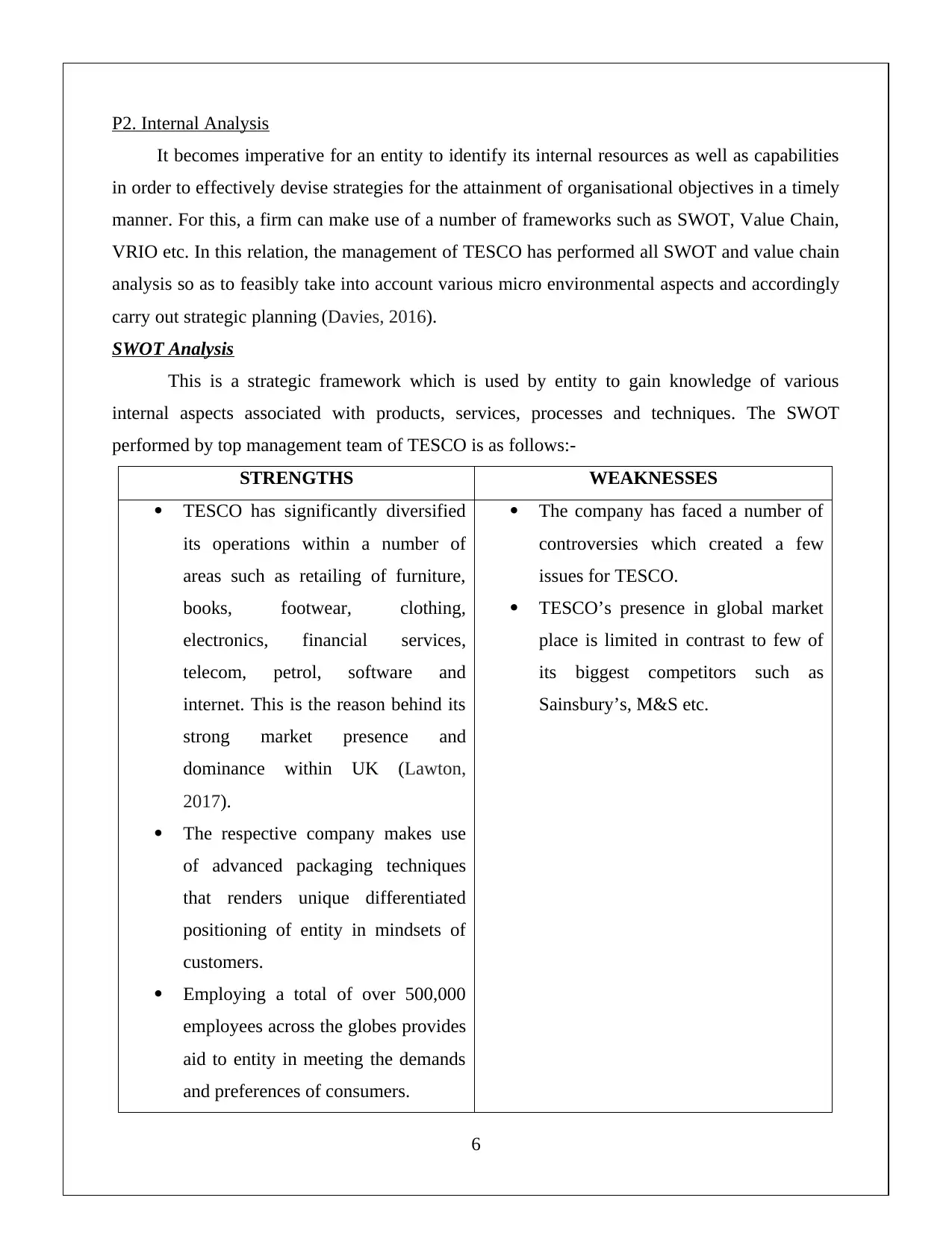
P2. Internal Analysis
It becomes imperative for an entity to identify its internal resources as well as capabilities
in order to effectively devise strategies for the attainment of organisational objectives in a timely
manner. For this, a firm can make use of a number of frameworks such as SWOT, Value Chain,
VRIO etc. In this relation, the management of TESCO has performed all SWOT and value chain
analysis so as to feasibly take into account various micro environmental aspects and accordingly
carry out strategic planning (Davies, 2016).
SWOT Analysis
This is a strategic framework which is used by entity to gain knowledge of various
internal aspects associated with products, services, processes and techniques. The SWOT
performed by top management team of TESCO is as follows:-
STRENGTHS WEAKNESSES
TESCO has significantly diversified
its operations within a number of
areas such as retailing of furniture,
books, footwear, clothing,
electronics, financial services,
telecom, petrol, software and
internet. This is the reason behind its
strong market presence and
dominance within UK (Lawton,
2017).
The respective company makes use
of advanced packaging techniques
that renders unique differentiated
positioning of entity in mindsets of
customers.
Employing a total of over 500,000
employees across the globes provides
aid to entity in meeting the demands
and preferences of consumers.
The company has faced a number of
controversies which created a few
issues for TESCO.
TESCO’s presence in global market
place is limited in contrast to few of
its biggest competitors such as
Sainsbury’s, M&S etc.
6
It becomes imperative for an entity to identify its internal resources as well as capabilities
in order to effectively devise strategies for the attainment of organisational objectives in a timely
manner. For this, a firm can make use of a number of frameworks such as SWOT, Value Chain,
VRIO etc. In this relation, the management of TESCO has performed all SWOT and value chain
analysis so as to feasibly take into account various micro environmental aspects and accordingly
carry out strategic planning (Davies, 2016).
SWOT Analysis
This is a strategic framework which is used by entity to gain knowledge of various
internal aspects associated with products, services, processes and techniques. The SWOT
performed by top management team of TESCO is as follows:-
STRENGTHS WEAKNESSES
TESCO has significantly diversified
its operations within a number of
areas such as retailing of furniture,
books, footwear, clothing,
electronics, financial services,
telecom, petrol, software and
internet. This is the reason behind its
strong market presence and
dominance within UK (Lawton,
2017).
The respective company makes use
of advanced packaging techniques
that renders unique differentiated
positioning of entity in mindsets of
customers.
Employing a total of over 500,000
employees across the globes provides
aid to entity in meeting the demands
and preferences of consumers.
The company has faced a number of
controversies which created a few
issues for TESCO.
TESCO’s presence in global market
place is limited in contrast to few of
its biggest competitors such as
Sainsbury’s, M&S etc.
6

This entity has a total of 6500 outlets
situated within 14 nations across the
world (Scholes, 2015).
It has its strong market positioning
owing to its robust marketing as well
as advertisement strategies.
The financial strength of this
company can be acknowledged on
the basis of listing within FTSE and
LSE.
The company constantly carry out
training sessions for its employees so
that the skills and knowledge of
personnel can be significantly
enhanced.
TESCO invests heavily in marketing
activities as a strategy to feasibly
gain the attention of a large number
of people.
Organisation operates in online as
well as offline format for enhancing
its sales and profits.
OPPORTUNITIES THREATS
TESCO can plan to enter into
emerging markets and expand the
area of its operations.
TESCO can significantly leverage the
digital media in order to expand its
reach
The respective company can carry
out acquisition of small retail chains
Products & services can be imitated
by competitors so constant innovation
is required by TESCO in order to
achieve uniqueness.
Government policies and taxation can
affect business operations of TESCO.
High competition from supply side as
maintaining relationships with them
7
situated within 14 nations across the
world (Scholes, 2015).
It has its strong market positioning
owing to its robust marketing as well
as advertisement strategies.
The financial strength of this
company can be acknowledged on
the basis of listing within FTSE and
LSE.
The company constantly carry out
training sessions for its employees so
that the skills and knowledge of
personnel can be significantly
enhanced.
TESCO invests heavily in marketing
activities as a strategy to feasibly
gain the attention of a large number
of people.
Organisation operates in online as
well as offline format for enhancing
its sales and profits.
OPPORTUNITIES THREATS
TESCO can plan to enter into
emerging markets and expand the
area of its operations.
TESCO can significantly leverage the
digital media in order to expand its
reach
The respective company can carry
out acquisition of small retail chains
Products & services can be imitated
by competitors so constant innovation
is required by TESCO in order to
achieve uniqueness.
Government policies and taxation can
affect business operations of TESCO.
High competition from supply side as
maintaining relationships with them
7
⊘ This is a preview!⊘
Do you want full access?
Subscribe today to unlock all pages.

Trusted by 1+ million students worldwide

and tie-ups in order to enhance the
market positioning.
is a big concern for TESCO.
Porter Value Chain Analysis
Value chain analysis helps business organisation in finding out activities so that value
could be added to company and its products so that competitive advantage could be gained by
them. With reference to TESCO, value chain analysis has been stated as below:
Primary Activities
Inbound logistics:
For TESCO, its inbound logistics is highly complex which supply bulk of products in
around 7820 stores across the world. It can be said that economies of scale is the major scope for
company’s operations that provides value to TESCO (Veit and et. al., 2014).
Operations:
Operations of TESCO are mainly divided into three sections that is retail, manufacturing
and banking. Retail includes Metro, Superstore, Extra and Express. Manufacturing includes
grocery retail chain and its banking sector includes TESCO bank.
Outbound logistics
Value chain creation of TESCO’s outbound logistics is flexibility and cost effectiveness
of delivery. The company provides home delivery services to its customers for some nearby
locations.
Marketing and sales:
TESCO’s marketing team has adopted strategy of using both online as well as offline
marketing activities for grabbing attention of maximum customers. Effective marketing strategy
helps the company in gaining competitive advantage. Its identified cost of these marketing
activities in UK is around two third of TESCO’s overall revenue.
Service:
TESCO is using cost leadership as its business strategy but still it’s difficult for the
company to influence interest of customer go use high standard products. Therefore, company is
now focusing on reducing prices of products but at the same time for providing products with
high quality directly requires additional cost to be added on.
Secondary Activities
8
market positioning.
is a big concern for TESCO.
Porter Value Chain Analysis
Value chain analysis helps business organisation in finding out activities so that value
could be added to company and its products so that competitive advantage could be gained by
them. With reference to TESCO, value chain analysis has been stated as below:
Primary Activities
Inbound logistics:
For TESCO, its inbound logistics is highly complex which supply bulk of products in
around 7820 stores across the world. It can be said that economies of scale is the major scope for
company’s operations that provides value to TESCO (Veit and et. al., 2014).
Operations:
Operations of TESCO are mainly divided into three sections that is retail, manufacturing
and banking. Retail includes Metro, Superstore, Extra and Express. Manufacturing includes
grocery retail chain and its banking sector includes TESCO bank.
Outbound logistics
Value chain creation of TESCO’s outbound logistics is flexibility and cost effectiveness
of delivery. The company provides home delivery services to its customers for some nearby
locations.
Marketing and sales:
TESCO’s marketing team has adopted strategy of using both online as well as offline
marketing activities for grabbing attention of maximum customers. Effective marketing strategy
helps the company in gaining competitive advantage. Its identified cost of these marketing
activities in UK is around two third of TESCO’s overall revenue.
Service:
TESCO is using cost leadership as its business strategy but still it’s difficult for the
company to influence interest of customer go use high standard products. Therefore, company is
now focusing on reducing prices of products but at the same time for providing products with
high quality directly requires additional cost to be added on.
Secondary Activities
8
Paraphrase This Document
Need a fresh take? Get an instant paraphrase of this document with our AI Paraphraser

Procurement:
Procurement team of TESCO focuses on building up positive relationship with the
suppliers so that they could buy all raw materials at minimal cost.
Technology development:
TESCO is using highly advanced technology in its working life for improving their
productivity and minimising employee’s efforts. For this, its technology department is constantly
investing upon Research & Development department for bringing innovation in its products and
processes. Currently, TESCO is using automation machines for maximising its productivity and
making work of employees smoother (Peng, 2017).
Human resource management:
HR manager of TESCO is constantly conducting training sessions for its employees for
developing their existing skills and knowledge so that their working capability can be enhanced.
Firm infrastructure:
Management team of TESCO is using effective quality control technique for bringing
new infrastructure within the corporation.
P3. Porter Five Force Model
Porter’s five force model is considered as the framework that is helpful for them in
understanding competitiveness in the industry in effective manner. The framework also helps
companies in identifying potential strategy which contributes in maximising profitability of the
company positive manner (Mittal and Dhar, 2015). In relation to TESCO, its management team
have planned to conduct this analysis so that they can easily understand competition available in
their industry. All forces of this framework are described as below along with its influence over
stakeholders.
Threat of new entrants: Threat of this force is low for TESCO as the industry is already
dense in nature and there are numerous of market leaders available in the industry who are
leading it from many years. Therefore, it is difficult for new entrants to enter into this industry
because they require huge capital in order to give stiff competition to existing companies. While
looking its influence over customers, it can be said that these customers are not getting new
products from company and they have to pay prices to existing companies without any
bargaining. Thus, it can be said that TESCO has the opportunity to grab the advantage of lower
magnitude of this force to gain the attention of people towards its high quality offerings.
9
Procurement team of TESCO focuses on building up positive relationship with the
suppliers so that they could buy all raw materials at minimal cost.
Technology development:
TESCO is using highly advanced technology in its working life for improving their
productivity and minimising employee’s efforts. For this, its technology department is constantly
investing upon Research & Development department for bringing innovation in its products and
processes. Currently, TESCO is using automation machines for maximising its productivity and
making work of employees smoother (Peng, 2017).
Human resource management:
HR manager of TESCO is constantly conducting training sessions for its employees for
developing their existing skills and knowledge so that their working capability can be enhanced.
Firm infrastructure:
Management team of TESCO is using effective quality control technique for bringing
new infrastructure within the corporation.
P3. Porter Five Force Model
Porter’s five force model is considered as the framework that is helpful for them in
understanding competitiveness in the industry in effective manner. The framework also helps
companies in identifying potential strategy which contributes in maximising profitability of the
company positive manner (Mittal and Dhar, 2015). In relation to TESCO, its management team
have planned to conduct this analysis so that they can easily understand competition available in
their industry. All forces of this framework are described as below along with its influence over
stakeholders.
Threat of new entrants: Threat of this force is low for TESCO as the industry is already
dense in nature and there are numerous of market leaders available in the industry who are
leading it from many years. Therefore, it is difficult for new entrants to enter into this industry
because they require huge capital in order to give stiff competition to existing companies. While
looking its influence over customers, it can be said that these customers are not getting new
products from company and they have to pay prices to existing companies without any
bargaining. Thus, it can be said that TESCO has the opportunity to grab the advantage of lower
magnitude of this force to gain the attention of people towards its high quality offerings.
9
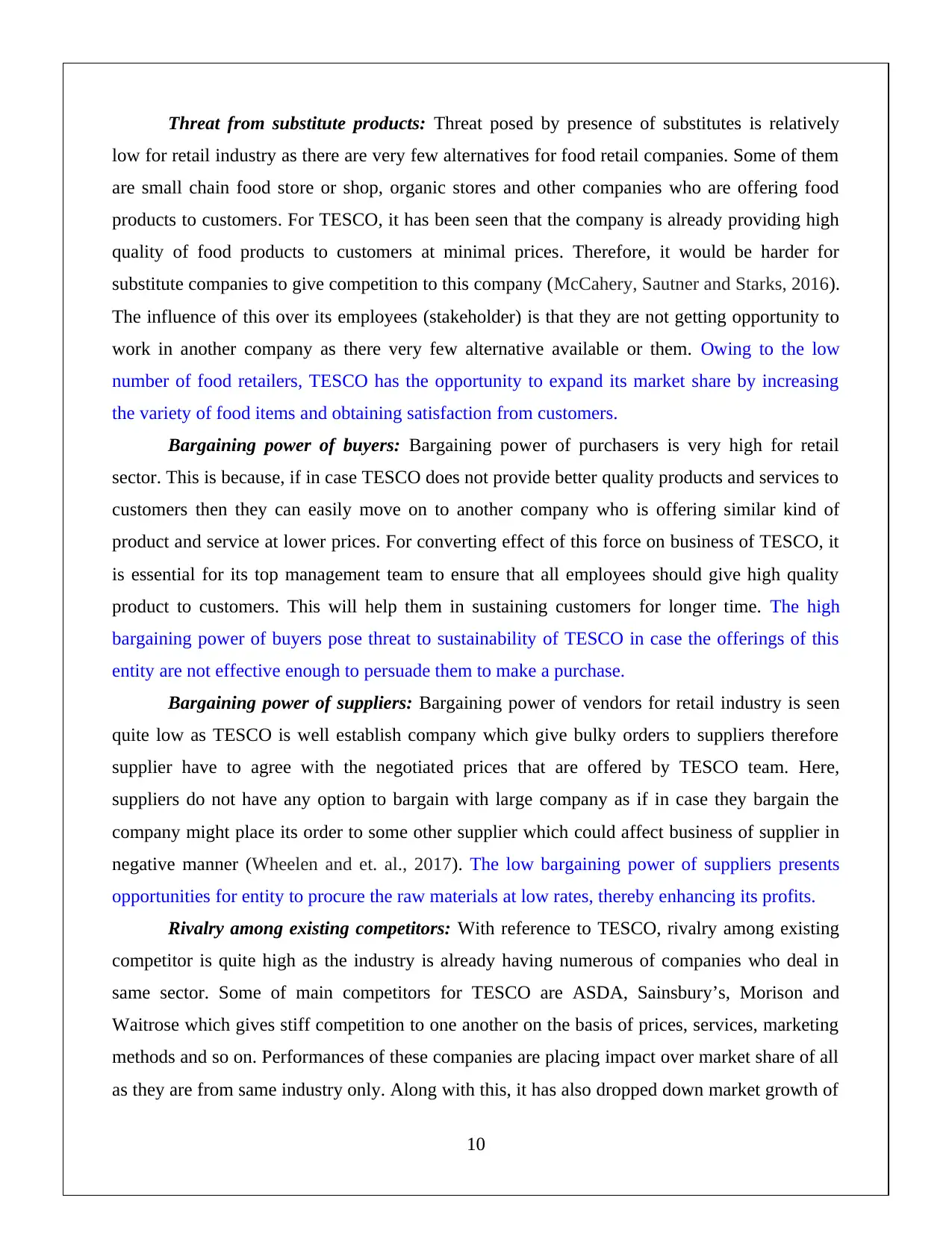
Threat from substitute products: Threat posed by presence of substitutes is relatively
low for retail industry as there are very few alternatives for food retail companies. Some of them
are small chain food store or shop, organic stores and other companies who are offering food
products to customers. For TESCO, it has been seen that the company is already providing high
quality of food products to customers at minimal prices. Therefore, it would be harder for
substitute companies to give competition to this company (McCahery, Sautner and Starks, 2016).
The influence of this over its employees (stakeholder) is that they are not getting opportunity to
work in another company as there very few alternative available or them. Owing to the low
number of food retailers, TESCO has the opportunity to expand its market share by increasing
the variety of food items and obtaining satisfaction from customers.
Bargaining power of buyers: Bargaining power of purchasers is very high for retail
sector. This is because, if in case TESCO does not provide better quality products and services to
customers then they can easily move on to another company who is offering similar kind of
product and service at lower prices. For converting effect of this force on business of TESCO, it
is essential for its top management team to ensure that all employees should give high quality
product to customers. This will help them in sustaining customers for longer time. The high
bargaining power of buyers pose threat to sustainability of TESCO in case the offerings of this
entity are not effective enough to persuade them to make a purchase.
Bargaining power of suppliers: Bargaining power of vendors for retail industry is seen
quite low as TESCO is well establish company which give bulky orders to suppliers therefore
supplier have to agree with the negotiated prices that are offered by TESCO team. Here,
suppliers do not have any option to bargain with large company as if in case they bargain the
company might place its order to some other supplier which could affect business of supplier in
negative manner (Wheelen and et. al., 2017). The low bargaining power of suppliers presents
opportunities for entity to procure the raw materials at low rates, thereby enhancing its profits.
Rivalry among existing competitors: With reference to TESCO, rivalry among existing
competitor is quite high as the industry is already having numerous of companies who deal in
same sector. Some of main competitors for TESCO are ASDA, Sainsbury’s, Morison and
Waitrose which gives stiff competition to one another on the basis of prices, services, marketing
methods and so on. Performances of these companies are placing impact over market share of all
as they are from same industry only. Along with this, it has also dropped down market growth of
10
low for retail industry as there are very few alternatives for food retail companies. Some of them
are small chain food store or shop, organic stores and other companies who are offering food
products to customers. For TESCO, it has been seen that the company is already providing high
quality of food products to customers at minimal prices. Therefore, it would be harder for
substitute companies to give competition to this company (McCahery, Sautner and Starks, 2016).
The influence of this over its employees (stakeholder) is that they are not getting opportunity to
work in another company as there very few alternative available or them. Owing to the low
number of food retailers, TESCO has the opportunity to expand its market share by increasing
the variety of food items and obtaining satisfaction from customers.
Bargaining power of buyers: Bargaining power of purchasers is very high for retail
sector. This is because, if in case TESCO does not provide better quality products and services to
customers then they can easily move on to another company who is offering similar kind of
product and service at lower prices. For converting effect of this force on business of TESCO, it
is essential for its top management team to ensure that all employees should give high quality
product to customers. This will help them in sustaining customers for longer time. The high
bargaining power of buyers pose threat to sustainability of TESCO in case the offerings of this
entity are not effective enough to persuade them to make a purchase.
Bargaining power of suppliers: Bargaining power of vendors for retail industry is seen
quite low as TESCO is well establish company which give bulky orders to suppliers therefore
supplier have to agree with the negotiated prices that are offered by TESCO team. Here,
suppliers do not have any option to bargain with large company as if in case they bargain the
company might place its order to some other supplier which could affect business of supplier in
negative manner (Wheelen and et. al., 2017). The low bargaining power of suppliers presents
opportunities for entity to procure the raw materials at low rates, thereby enhancing its profits.
Rivalry among existing competitors: With reference to TESCO, rivalry among existing
competitor is quite high as the industry is already having numerous of companies who deal in
same sector. Some of main competitors for TESCO are ASDA, Sainsbury’s, Morison and
Waitrose which gives stiff competition to one another on the basis of prices, services, marketing
methods and so on. Performances of these companies are placing impact over market share of all
as they are from same industry only. Along with this, it has also dropped down market growth of
10
⊘ This is a preview!⊘
Do you want full access?
Subscribe today to unlock all pages.

Trusted by 1+ million students worldwide
1 out of 17
Related Documents
Your All-in-One AI-Powered Toolkit for Academic Success.
+13062052269
info@desklib.com
Available 24*7 on WhatsApp / Email
![[object Object]](/_next/static/media/star-bottom.7253800d.svg)
Unlock your academic potential
Copyright © 2020–2025 A2Z Services. All Rights Reserved. Developed and managed by ZUCOL.




